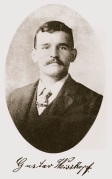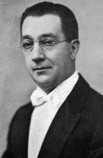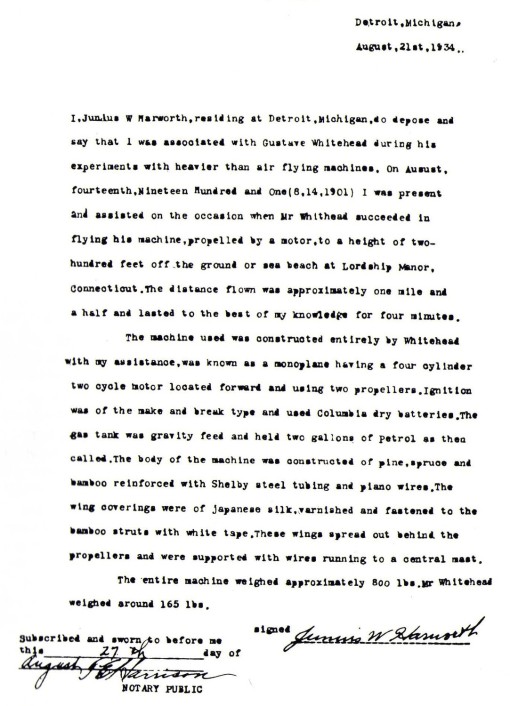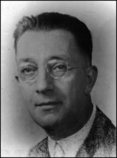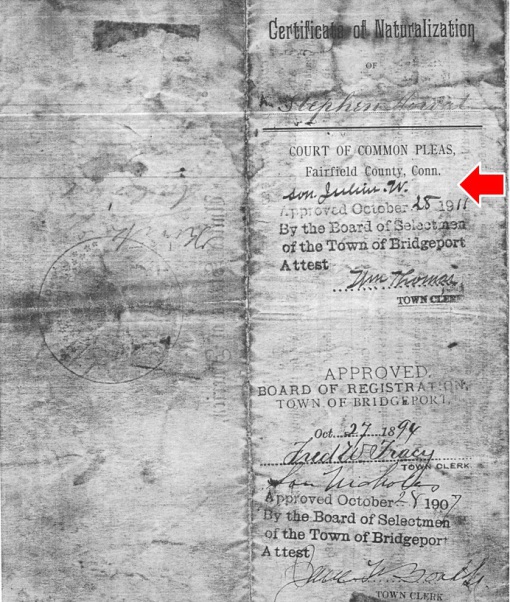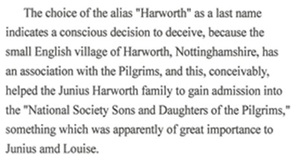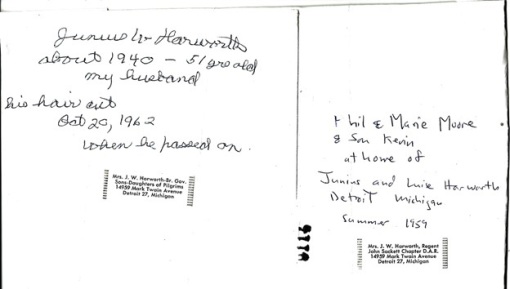Affidavit of Junius Harworth III (Gyula Horvath)
I, Junius W. Harworth, residing at Detroit, Michigan do depose and say that I was associated with Gustave Whitehead during his
experiments with heavier than air flying machines. On August, fourteenth, Nineteen Hundred and One (8.14.1901) I
was present and assisted on the occasion when Mr. Whithead succeeded in flying his machine, propelled by a motor, to a height of two-hundred feet off the ground or sea beach
at Lordship Manor, Connecticut. The distance flown was approximately one mile and a half and lasted to the best of my knowledge for four minutes.
The machine used was constructed entirely by Whitehead with my assitance, was known as a monoplane having a four cylinder two cycle
motor located forward and using two propellers. Ignition was of the make and break type and used Columbia dry batteries. The
gas tank was gravity feed and held two gallons of petrol as then called. The body of the machine was constructed of pine,
spruce and bamboo reinforced with Shelby steel tubing and piano wires. The wing coverings were of japanese silk, varnished and fastened to the bamboo
struts with white tape. These wings spread out behind the propellers and were supported with wires running to a central mast. The
entire machine weighted approximately 800 lbs. Mr Whitehead weighed around 165 lbs.
Letter of Junius Harworth to Stella Randolph, Jan. 24, 1936
Before the Wrights Flew, pp. 86-87
Relative to the midsummer trials in 1901 on Pine Street with machine #21, the first attempt took place along the Bridgeport Gas Company property, flying or hopping from Howard Avenue eastward to to Wordin Avenue. At the eastern end of Pine Street, near the railroad tracks, we had ample room to turn the machine about, and flew and hopped to Howard Avenue. We homes on both sides and trees, we felt it risky so pushed the machine westward to Hancock Avenue, then from here on a flight was made, the machine rising about five feet. Harworth continued by saying this was the flight Alexander Gluck made affidavit to on July 19, 1934.
Contribution by Junius Harworth's Niece, Martha Schipul:
JULIUS HARWORTH
What Julius Knew
by Martha Matus Schipul
In an internet blog, a Wright brothers advocate, Carroll F. Gray, posted an assault on the credibility of my great uncle Julius, titled “Wandering Diogenes—Truth & Junius Wentworth Harworth III Gyula Horvath” www.flyingmachines.org/gwinfo/JWHtruth.html , posted July 26,2013. In it, the blog writer makes a series of unfounded accusations for which he gives the reader almost no sources. Among these are allegations that my great uncle, an immigrant, Americanized his name for fraudulent purposes, that he lied in government documents about being a United States citizen, and that he lied about events he witnessed. The blogger also alleges that because my great uncle signed a contract for a small percentage of Stella Randolph’s book, The Lost Flights of Gustave Whitehead, Julius must have falsified information. In addition, the blogger uses a feud between Julius and his brother Nicholas, my grandfather, to discredit Julius. All of the blogger’s allegations are demonstrably false: in many cases, it appears they may be deliberately false. Because of the egregious nature of these allegations, I have decided to set the record straight.
As a former university lecturer and high school teacher, I’m accustomed to correcting research papers. However, the blogger’s fourteen-page screed barely rises to high school level. With nary a footnote, nor a source, it would receive a failing grade if submitted as a high school term paper. The reader is given neither source nor context for quotations, thus frustrating the formulation of a response. To cite just one example; without appropriate attribution, the blogger appears to have obtained some of his information from Ancestry.com where my family’s immigration from Kassa (now Kosice, Slovakia) is recorded. Such sloppy sourcing, unattributed “lifting” of material, and misinterpretation of sources permeate the entire blog.
After several visits to the Fairfield [Connecticut], Historical Society, I was able to solve the mystery of the likely origin of the quotations the blogger uses. They are found in correspondence between Uncle Julius and Stella Randolph, the author of Lost Flights of Gustave Whitehead (Places, Washington D.C., 1937), along with many other documents connected with Gustave Whitehead, assiduously collected by Major William O ‘Dwyer (author with Stella Randolph of History by Contract, Fritz Majer und Sohn, Leutershausen, Germany, 1978), and deposited at the Fairfield Historical Society. The reason the blogger does not reveal his sources can only be speculated upon.
1. The Writer displays apparent ignorance of naturalization law
According to the blogger, “he [Julius] lied about being a naturalized citizen” on his WWI draft card (Carroll F. Gray, “Wandering Diogenes” ). However, according to the naturalization papers of my great grandfather, Stephen Horvath, his sons, Nicholas and Julius, received what’s commonly known as “derivative citizenship” from their father because they were both minors when Stephen became a citizen. The following is the front and back of the citizenship document (in the possession of my cousin, Philip Moore):
Since the blogger has apparently spent a great deal of time going through ancestry.com, it is surprising that he would not have reviewed the section on derivative citizenship.
2. The Writer falsely alleges fraud regarding the Americanization of my uncle’s name
We always knew him as Uncle Julius, even though we were aware of his name change to “ Junius Harworth,” at the behest of his wife and mother-in-law. Contrary to the blogger’s allegations that Julius’s name change was kept from the family, the introductory letter from Stella Randolph to Julius explains that Ms. Randolph went to my grandfather’s pharmacy to find the address of “Wentworth. J. Hurvath,” and my grandfather immediately suggested she contact his brother in Detroit (letter, Stella Randolph to Junius Harworth, July 15, 1934, William O’Dwyer Collection, Fairfield, Connecticut Historical Society). My grandfather obviously knew of the name change, as did my mother, Grace Horvath Matus, who was also working in the drugstore at that time and described that encounter to me on several occasions. The neighbors who had directed Ms. Randolph to the pharmacy also apparently knew of the name change.
The blogger states that my uncle, Julius Horvath, used an “alias,” ”Junius Wentworth Harworth III” rather than referring to it as an “Americanization” of his name (Gray, “Wandering Diogenes”). The blogger suggests this was done with fraudulent intent. I wonder how many of the readers of the blog would be deeply offended by the suggestion that any name change by their ancestors was an intent to deceive? It’s hard to fathom that anyone writing about any aspect of the history of this country would have such an anti-immigrant view of our heritage.
Nowadays, the term, “alias,” is often used to describe a person accused of a crime. In this context, the blogger construes an interview given by me to the late Dr. Robert Kranyik to suggest that my uncle affected his name-change to fraudulently gain membership in the organization, “Sons and Daughters of Pilgrims.” The truth is that there is no evidence that Julius was ever a member of that organization or of any other organization for descendants of early settlers.
The writer indulges in wild speculation:
Julius’s wife, Louise, joined the organization, “Sons and Daughters…” as well as several other organizations for colonial descendants. She was fully qualified to join these groups based on her own family’s heritage. She didn’t need her husband’s participation. On her mother’s side, she was a ninth generation descendent of the Pilgrim Andrew Ward, founder of Wethersfield and Stamford, Connecticut and among the first residents of Fairfield, Connecticut. He arrived in Watertown, Massachusetts in 1633 with William Bradford. This excerpt is from Sixteen Hundred Lines to the Pilgrims Lineage, Book III, Genealogical Publishing Company, Middlebury, Connecticut, 1982, 30:
It is noteworthy that Louise would also have qualified for membership in these organizations based on her father William Rosa Swan’s descent from Pilgrim ancestor. The paternal line is William Rosa Swan 1862-1938,Dr. Grosvenor Swan 1819-1891,Abel Swan 1789-date of death unknown in New York, Josiah Swan Jr. 1747-1822, Reverend Josiah Swan Sr.1711-1777, Captain Ebenezer Swan 1684, died at sea, 1716, Thomas Swan Jr. 1669-1710, Thomas Swan Sr. 1642(Roxbury Massachusetts)-1688.Thomas’s parents were Henry Swan, 1675-? and Joane Ruck(e) (born in 1620 in Cranbrook, Kent, England), who arrived in Salem, Massachusetts in 1639 from Rothersfield, Sussex, England. (Ancestry.com)
Louise served as Brigadier Governor of the “Sons and Daughters of the Pilgrims, Detroit Chapter,” and was also a member of the “Daughters of the American Revolution” where she served as Regent of the John Sackett Chapter as well as several other such organizations. Indeed, activities with these groups took up much of her time. The following are her address labels sent on letters to my cousin Philip Moore: the first from the back of a photograph in a letter of 1962 and the second from the back of a photograph in a letter sent in 1959. The handwriting on the left is Louise’s; that on the right is Philip Moore’s:
The blogger appears to be on a “fishing expedition” with many of the allegations he raises. Although it is unworthy of the label, “research,” such angling will occasionally bring up something. It is evident that, because of their colonial heritage, Louise and her mother didn’t want people to know that Louise had married a man of Eastern European origin. In the early days of the 20th Century, prejudice against persons of non-Anglo-Saxon heritage was strong (“Racial discrimination in America During the early part of the 20th Century” http://www.123helpme.com/view.asp?id=23257). Hungarians, Slovaks, Poles etc. were discriminated against in hiring and housing, and were banned from many clubs and organizations. During WWI, this discrimination intensified when the Austro-Hungarian government sided with the German Kaiser and further in WWII when Hungary was allied with the Third Reich.
As a child, I spent time with Uncle Julius and Aunt Louise on several occasions when they came to visit the family. Aunt Louise was a formidable woman who was visibly uncomfortable with having to visit her husband’s “foreign” relatives. So it should be no surprise that Uncle Julius decided to Americanize his name.
3. The Blogger gets the reason for my uncle’s grade school name wrong
The blogger even insinuates that my uncle’s first attempt to deceive authorities was as a schoolboy in the Elias Howe Elementary School (Gray, “Wandering Diogenes”). There, my uncle was listed as “Julius Hooey” and his older brother (my grandfather) as “Michael Hoey.” The blogger questions the name change. If the blogger were really interested, he could have asked our family. Our grandfather, Nicholas, told us that when he entered elementary school, the Anglo-Saxon teacher insisted she couldn’t pronounce the name “Horvath” and that “Miklos” [Hungarian for” Nicholas”] sounded like “Michael.” So, thereafter, she called him “Michael Hoey.” And when Julius entered school two years later, he was also assigned the name “Hoey.” The writer states, “Why that name was used, even Gyula wasn’t certain.” This is a paraphrase of a letter from Julius to Stella Randolph, January 27, 1935(Detroit, O’Dwyer Collection, Fairfield Historical Society). It’s not hard to figure out why young Julius wasn’t certain, since he wasn’t around when the name,”Hoey,” was first awarded. The point is, do these circumstances support the blogger’s view that a five-year-old was a party to deception and on the verge of beginning a life of fraud?
4. The Blogger demonstrates ignorance of census procedure
In a section entitled ‘This Name…That Name…This Birthplace…That Birthplace,’ the blogger cites discrepancies among several censuses in an effort to “prove” that Julius was an incorrigible liar.
Any trained historian should know that information taken down by paid census takers was not necessarily provided by the head of the household, but by anyone who happened to be home at the time, or even by neighbors. Indeed, Ancestry.com outlines the limitations of census taking as follows:
When questions were answered by someone other than the subject of the inquiry, the likelihood of error increased. A husband or wife might not always know the birthplace of a spouse’s parents. A child being quizzed might easily be unsure of the birthplace of his or her parents. Census schedules do not tell us who answered the enumerator’s questions (Ancestry.com 6).
Furthermore, the census-taker him/herself often had his/her own set of limitations. The answers were not legally binding: ”An important point to remember is that the enumerator simply wrote down the responses given to them. They were not authorized to request any kind of proof, such as birth, marriage, or property ownership records” (Ancestry.com 6).
Another problem involved the competence of the census taker:
Individuals were not necessarily well-educated or qualified for the job, and anyone who has studied census records knows that good penmanship was not a requirement. Census takers were political appointees who were frequently chosen because they were of the correct political affiliation in a particular time and place, or just knew the right people (Ancestry.com 7).
The language barrier was another obvious problem:
Often enumerators could hardly understand the information given to them by people with foreign accents. Names were frequently misunderstood and misspelled by the enumerators, to the extent that many do not even begin with the correct letters. (Ancestry.com 7)
I remember a time when the census taker came to my door. After I provided information about our family, the census taker then asked questions about my neighbors to either side, neither of whom was home.
No one could possibly know who was home to answer the questions of the census-taker at Julius’s house. It could have been Louise; it could have been Gertrude; it could have been Donald (Louise and Julius’s son); or the information could have come from a neighbor. Perhaps the census taker didn’t write down the information accurately. This is far from “proof” that Julius was an inveterate liar.
5. The Blogger even gets the facts surrounding the first Harworth/Whitehead meeting wrong
In his “Introduction,” the blogger states “Horvath began his long association with Gustav Weisskopf/ Gustave Whitehead in 1900 at the age of 12. His first job with Whitehead was to safeguard a trunk which Whitehead had just retrieved from Bridgeport’s train station” (Gray, “Wandering Diogenes”). Actually, Mr. Whitehead first encountered Julius when he was looking for lodging upon arrival in Bridgeport’s West End. Julius told him that his parents’ landlord, Mr. Egry, had an available rent. This is corroborated in Stella Randolph’s The Story of Gustave Whitehead: Before the Wrights Flew (New York, G.P. Putnam’s Sons, 1966, 74 taken from a letter from Julius to Stella (October 7, 1934, O’Dwyer Collection) as follows:
It was Junius Harworth who took him upstairs to the flat occupied by the Egrys when Whitehead first arrived in Bridgeport. Junius, a boy of about eleven years, just happened, as boys do, to be in the candy and tobacco shop located on the first floor of the building at 352 Hancock Avenue. He had noticed Whitehead, a stranger, on his way to the shop, and he was quite ready to volunteer help when Whitehead inquired of the shop owner where he could secure lodgings. This was the beginning of a number of years of close association of the man and boy.
In the subsequent paragraph, Randolph writes that the incident with the trunk occurred shortly after this first meeting at a later date when Whitehead had materials sent to him from Pittsburgh(Before the Wrights Flew, 74) in a letter of October 7, 1934 from Julius to Stella(also in O’Dwyer Collection). The trunk incident is also described in Lost Flights of Gustave Whitehead, without representation, that it was their first meeting (Places Inc., Washington D.C. 1937, 31.) How did the writer miss these sources?
6. The Blogger offers a one-sided, illogical and unfounded interpretation of “conflict of interest”
The blogger states that Ms. Randolph signed my great uncle Julius to an exclusive contract with a 5% royalty on the proceeds of Lost Flights. The writer then comments, “Of course, such a financial arrangement between an author and a source is generally frowned upon because a witness to events about which the author is writing would then have a financial incentive to concoct material”(Gray, “Wandering Diogenes”). What the blogger doesn’t mention is that it is standard for witnesses to be reimbursed for their time and out-of-pocket expenses, and that my great uncle was a well-paid Packard engineer whose time was valuable. What is certain is that there is no evidence that either Ms. Randolph or my great uncle Julius actually derived any financial benefit from Lost Flights. What’s also certain is that paid researchers cannot be presumed to be liars. For example: in a court of law, expert witnesses are routinely compensated for their time, travel expenses etc.
I wonder what the blogger’s opinion is concerning the Wright family’s notorious, once secret, exclusive contract with the Smithsonian. It clearly violates academic principles by dictating history. The Wright family, Wright biographers and various museums have derived considerable income from it over the decades. It’s outrageous to nitpick about my great uncle’s expenses (which were never reimbursed) when such a glaringly inappropriate contract is used to support an erroneous version of mainstream aviation history.
7. Prof. Crane’s initial theory (1936) – rather than his final conclusion (1949) – is selectively used by the writer to attack my uncle’s credibility
When the blogger finally does attribute a source to a quotation, it is Professor John B. Crane’s 1936 article, “Did Whitehead Actually Fly?” in which Crane writes, “evidence that Whitehead made genuine, sustained, horizontal flight at any time is inconclusive”(N.A. A. Magazine. Washington D.C. December 1936). The writer suggests this is “proof” that Crane doubted Whitehead’s claim (Gray, “Wandering Diogenes”). Although the blogger said that Crane “considered” asking for a Congressional investigation, Crane quite definitely did make a very public announcement of his intent to the Associated Press very shortly later, in 1937, because he believed there was sufficient evidence to support Whitehead’s claim (“Asks Congress to Decide if Local Man was the first to Invent the Airplane: Harvard Professor sure Gustave Whitehead flew in machine he invented before the Wright Brothers – Widow here tells of first flight,” Times Star, Bridgeport, Connecticut, January 18, 1937, retyped, O’Dwyer Collection). The blogger also neglects to cite letters between E. E. Husting of Boston and Dr. Crane (E.E. Husting to John Crane, April 19, 1968, Boston, Massachusetts, O’Dwyer Collection). Husting, an aviation buff, asks how Dr. Crane accounts for his about-face in the space of a year concerning whether or not Whitehead flew. “Can you direct me to the actual papers that were the basis for your conclusions if they still exist?" Dr. Crane replied in a letter of April 26, 1968, “I am convinced in my own mind that Whitehead made short straightaway flights a few feet above the ground.” Later in the same letter he commented, “as you may readily understand, I do not remember what I said in the 1936 article in the N.A.A. Magazine. In fact, I had forgotten ever having written such an article”(Mount Pleasant, Iowa, O’Dwyer Collection). Finally, at the end of his diatribe, the blogger mentions in passing that in 1949 in the aviation journal, Air Affairs, Prof. Crane supported Whitehead’s claim: (“Early Airplane Flights Before the Wrights,” Air Affairs , Vol. 2, Winter, 1949). Here is the complete Crane quotation from 1949 that the blogger fails to supply to the reader, but is presented here to put it into context:
But before the Wrights achieved successful powered flights in December of 1903, two other American experimenters both New Englanders, had succeeded in making successful powered airplane flights. These were Gustav Whitehead of Bridgeport, Connecticut, and John Hall, of Springfield, Massachusetts….Gustav Whitehead’s flights were the earlier and consisted of several short straight-line flights of up to 300 feet or more in length near the edge of Bridgeport between 1900 and 1902, as well as longer flights in 1901 and 1902 (“Early Flights before the Wrights,” Air Affairs, Vol. II Winter, 1949, 514. Washington D.C.)
Why does the blogger emphasize Prof. Crane’s initial hypothesis rather than Crane’s final conclusion? Since the blogger obviously had knowledge of Prof. Crane’s final conclusion and the call for a Congressional investigation, it would appear that the blogger is intentionally deceiving or misleading his readers.
8. The Blogger falsely accuses Julius of being Crane’s chief source of information, thus breaking his contract with Stella Randolph
Julius revealed in a letter to Stella, dated August 27, 1936 that Crane, having been shown his affidavit by Albert Zahm in the Library of Congress, visited Julius in Detroit trying to wheedle information and pictures out of him, especially of Whitehead’s airplane in flight. Crane tried using flattery: “my signature seemed so outstanding, that it must belong to a person of intelligence and integrity,” (Junius Harworth to Stella Randolph, Detroit, Michigan, O’Dwyer Collection). Julius added, “But he did not get very much information from me and I told him that he could get all of it just as soon as you desired to give it to him.” Ibid
Stella Randolph answered Julius in a letter of September 2, 1936 (Washington D.C., O’ Dwyer Collection):”He called me up after he had seen you and told me you had told him I had a picture of Whitehead in his machine in flight, but that you could not show it to him as you had just sent the pictures to me.”…. He was trying to surprise me into committing myself as to whether I had such a picture.” Dr. Crane left without getting anything from her. The only material Dr. Crane had from Julius in his N.A. A. article was Julius’s affidavit that Crane had found in the Library of Congress before he had even talked to Julius. It was only a short time later that Crane reversed his opinion and asked for a Congressional investigation. Years later, as previously stated, he said he did not even remember writing the initial article (John Crane to E. E. Husting, April 26, 1968, Mount Pleasant, Iowa, O’Dwyer Collection).
By the way, it is obvious that Stella did not have a clear photograph of the airplane in flight. Julius mentions on more than one occasion the difficulty of taking a picture of a moving object in the middle of the night back in the early 1900’s. Otherwise, it would most certainly have shown up in Lost Flights.
9. The Blogger quotes selectively to misrepresent facts
In his section entitled ’Alienation,’ the blogger mentions an interview by Dr. Crane of my grandfather Nicholas Horvath for the article, “Did Whitehead Actually Fly?”, in which he “asserts that he never once heard his younger brother mention the alleged one and one-half mile flight or the seven mile flight.” This excerpt from Crane’s N.A.A. article does not say that Nicholas knew nothing about Whitehead’s flights in general; just that he could not recall his brother mentioning those two particular flights. Furthermore, the blogger, in his introduction, provides the reader with an answer when he quotes Julius in a letter to Stella Randolph writing: “I did not say a thing to anyone about it [the flights], much less my brother.” (Harworth to Randolph, March 8, 1937, O’Dwyer Collection)
Next, the blogger cites the same letter of March 8, 1937 about the rivalry between the brothers, Julius and Nicholas which provides an answer to many of the questions the writer raises. It concerns a practical joke Nicholas played on his younger brother and Julius’s retaliation. I was aware of the occasional jealousy between the brothers. However, during my childhood, Uncle Julius and Aunt Louise came to visit Bridgeport from Detroit at least once a year. If there were that much enmity still existing between the brothers, why would Julius and Louise have made the long trip to see his family?
I know, first hand, and can attest to the fact that my grandfather was very proud of the contributions his brother, Julius, made in support of Gustave Whitehead’s efforts, as was our entire family. We grandchildren were told about the flights many times ever since we were old enough to comprehend. In addition, William O’Dwyer in a letter to Dr. Crane said that my grandfather would tell the neighborhood children about Mr. Whitehead’s flights. ”Oddly enough the druggist [my grandfather, Nicholas] would often tell about GW’s flights and his short flights ‘in the nearby streets and open lots’ near his store [corner of Pine Street and Bostwick Avenue] to the children in that same neighborhood!” (O’Dwyer to Crane, September 8, 1982, Fairfield CT, O’Dwyer Collection).
Uncle Julius had in his possession correspondence between Whitehead and other early pioneers. I distinctly remember him showing me a letter addressed to Whitehead by Otto Lilienthal’s brother, Gustav, and one by Alberto Santos-Dumont. Unfortunately, it appears that my relatives may not have preserved these documents—if they ever indeed had them. It is also more than likely that someone outside of the family has them, if they still exist.
Also contained in Crane’s article, “Did Whitehead actually Fly?,” was the assertion that the flights were “news to everyone of Whitehead’s old neighbors and former helpers who still live in the vicinity of Pine Street”—a position very soon retracted by Crane but nevertheless quoted by the writer–whatever his motives (7). The statements of the seventeen witnesses who were sure they’d seen pre-1903 flights, many of them sworn before public notaries, today bears witness to the many pre-Wright flights by Gustave Whitehead ( Stella Randolph, Before the Wrights Flew, New York, G. Putnam Sons, 1962).
10. The Blogger invents imaginary inconsistencies
In the section of the blogger’s article entitled ‘He’s here… He’s there…’, a veiled allusion to the comic book hero, Superman, he uses a quotation from Lost Flights to support the idea that Julius was lying about being present at the August 14 flight because he said it was in Lordship, Stratford, whereas others had mentioned a dawn flight in Fairfield.
There’s no reason to believe that there weren’t more than one flight that day in different locations with different people being present at each. Unlike the Wright brothers’ plane which had to be launched from a stationary rail on a sand dune (or later with the help of a catapult) into a high wind, Whitehead’s plane was roadable and could easily be moved from one location to another. It is entirely possible that he experimented that day in the calm wind at dawn, then again at dusk somewhere else. Unlike the unstable Wrights’ plane, which was destroyed in less than two hours after several crashes (which the writer refers to as “controlled”), Whitehead’s plane was inherently stable, landed safely, and was available for subsequent flights. That‘s what inventors do: they perform and repeat experiments under varying conditions.
Summary:
There are numerous, serious problems of both method and fact in the blog, “Wandering Diogenes.” Luckily I was able to find the source of many of his quotations by taking time to visit the Fairfield Historical Society and read the file of letters between Julius and Stella as well as the material regarding Dr. Crane. The census documents can be found on Ancestry.com. If the blogger had identified his sources, the reader would have the benefit of knowing the context of his argument. It is this context that I have provided that reveals the specious nature of his arguments. It is obvious that the blogger was cherry-picking his quotations to put the worst possible spin on the matter.
As has been demonstrated, the material he uses from various censuses isn’t proof of anything, given the inherent accuracy problems with such sources. The blogger’s arguments, that my uncle lied about being a citizen and that he changed his name in order to get into the Sons and Daughters of the Pilgrims, are totally without merit. If the blogger truly believes his own baseless arguments, why isn’t he willing to provide the reader with his sources?
History should be written starting with the facts, not the conclusion. An erroneous conclusion easily results from misstating the facts, as one can readily see from Gray’s blog. My great uncle deserves his place in history as a credible witness to the fact that Gustav Weisskopf/Gustave Whitehead flew first. No contract or misleading screed will ever change that historical fact.
List of Works Consulted
Address labels of Louise Swan Harworth, courtesy of Philip Moore.
“Asks Congress to Decide if Local Man Was First to Invent Airplane”. Times Star. Bridgeport, Connecticut. January, 18, 1937. William O’Dwyer Collection, Fairfield, Connecticut Historical Society.
Citizenship document of Stephen Horvat[h]and sons, Nicholas and Julius. front and back. 1894,1907, 1911. In possession of Phillip Moore.
Crane, John B. “Did Whitehead Actually Fly?”. National Aeronautical Association Magazine. Washington D. C. December, 1936.
Crane, John B. John B. Crane to E. E. Husting, Mount Pleasant, Iowa, April 26, 1968. O’Dwyer Collection.
Crane, John B. “Early Airplane Flights before the Wrights.” Air Affairs. Vol. II, Winter. 1949.
Gray, Carroll F. “Wandering Diogenes-Truth and Junius Wentworth Harworth III, Gyula Horvath” in
Gustave Whitehead-What did He Do? Posted: July 26, 2013.
www.flyingmachines.org/gwinfo/JWHtruth.1html
Harworth, Junius. Junius Harworth to Stella Randolph, Detroit, Michigan, October 7, 1934.O’Dwyer Collection.
Harworth, Junius. Junius Harworth to Stella Randolph, Detroit Michigan, January 27, 1935.O’Dwyer Collection.
Harworth, Junius. Junius Harworth to Stella Randolph, Detroit, Michigan, January 24, 1936. O’Dwyer Collection.
Harworth, Junius. Junius Harworth to Stella Randolph, Detroit, Michigan, August, 27, 1936. O’ Dwyer Collection.
Harworth, Junius. Junius Harworth to Stella Randolph, Detroit, Michigan, March 8, 1937. O’Dwyer Collection
Harworth, Junius. Junius Harworth to Stella Randolph, Detroit Michigan, February 22, 1953. O’Dwyer Collection
Harworth, Louise Swan. Louise Swan Harworth to Phillip Moore with address label, Detroit, Michigan, 1959. courtesy of Philip Moore.
Harworth, Louise Swan. Louise Swan Harworth to Phillip Moore with address label, Detroit, Michigan, 1962. courtesy of Philip Moore.
Husting, E. E.. E. E. Husting to John Crane, Boston, Massachusetts, April 19, 1968. William O’Dwyer Collection.
Mayo, Mary E. Ed. Sixteen Hundred Lines to the Pilgrims. Lineage, Book III. Geneological Publishing Company. Middlebury, Connecticut.1982.
O’Dwyer, William and Randolph Stella, History by Contract. Fritz Majer und Sohn. Leutershausen, Germany. 1978.
O’Dwyer, William. William O’Dwyer to John Crane, Fairfield, Connecticut, September 8 1982.O’Dwyer Collection.
“Overview of the U.S. Census” http://www.ancestry.com/wiki/index.php?title=Overview_of_the_U.S._Census#Census_Taking (It originally appeared in Szucs, Loretto, Dennis and Wright, Matthew “Census Records” in The Source: a Guide to American Genealogy.
Photograph of Junius Harworth. courtesy of Philip Moore.
“Racial Discrimination in America During the 1920’s.” http://www.123helpme.com/view.asp?id=23257
Randolph, Stella. Before the Wrights Flew: the Story of Gustave Whitehead. New York. G. Putnam’s Sons.1966.
Randolph, Stella. Stella Randolph to Junius Harworth, Washington, D.C., July 15, 1934. O’Dwyer Collection.
Randolph, Stella. Stella Randolph to Junius Harworth, Washington, D.C., February 11, 1936. O’Dwyer Collection.
Randolph, Stella. Stella Randolph to Junius Harworth, Washington, D. C., September 2, 1936. O’Dwyer Collection.
Randolph, Stella. Lost Flights of Gustave Whitehead. Washington D.C. Places Inc. 1937.
Replacement form for lost immigration papers of Nicholas Horvath.1938. courtesy of Philip Moore.

